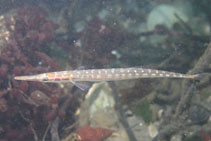| Family: |
Aulorhynchidae (Tubesnouts) |
| Max. size: |
18 cm TL (male/unsexed); max. reported age: 9 years |
| Environment: |
benthopelagic; marine; depth range 0 - 30 m |
| Distribution: |
Eastern Pacific: Sitka, Alaska to Punta Banda, northern Baja California, Mexico. |
| Diagnosis: |
Dorsal spines (total): 24-27; Dorsal soft rays (total): 9-10; Anal spines: 1-1; Anal soft rays: 9-9. Spinous dorsal represented by a series of small spines, free from membrane; soft dorsal fin triangular and placed well back on body; caudal fin small and finely forked; anal fin spine small and broad, the fin mirroring the soft dorsal fin; pectorals truncate (Ref. 6885). Pale mottled brown, varying from olive green to yellow brown dorsally; creamy white ventrally; a bright silvery patch between operculum and pectorals extending to throat and bounded above by a dark band that extends forward through eye to snout; breeding males with bright red snout and phosphorescent snout (Ref. 6885). |
| Biology: |
Found in kelp beds, eelgrass, rocky areas, and over sand bottoms (Ref. 2850). Usually near the surface in schools, sometimes in dense schools well offshore (Ref. 2850). Feeds on small crustaceans and fish larvae (Ref. 6885). Minimum depth reported taken from Ref. 57178. |
| IUCN Red List Status: |
Least Concern (LC); Date assessed: 08 March 2016 Ref. (130435)
|
| Threat to humans: |
harmless |
Source and more info: www.fishbase.org. For personal, classroom, and other internal use only. Not for publication.

